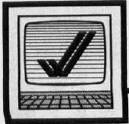
AmigaView
Sheldon Leemon
The AmiExpo
I've just returned from AmiExpo, the first large computer show devoted exclusively to the Amiga, and it was quite an event. The list of attendees reads almost like a Who's Who of Amigadom. Members of the original Amiga design team gave speeches about the development of the Amiga. The current Commodore team responsible for the Amiga's future also turned out in force. Everyone from Irving Gould, chairman of CBM, and Richard McIntyre, senior vice-president of marketing, down to the Amiga technical support staff, engineers, and customer support people were there to get the public's reaction to their efforts. Many of the software developers who wrote the programs being shown in the exhibit hall were in attendance. A large contingent of prominent Amiga users showed up, people who are well known in the Amiga community for their public domain software or for their involvement with national Amiga users groups. And of course, there were plain old Amiga fans from all over the world. All in all, nearly 10,000 people attended the three-day event.
Although over 50 Amiga hardware and software companies were listed as exhibitors, there were dozens more who shared booth space or just wandered around the show, promoting their products. I'll quickly mention some of the new products shown and go into further detail in future columns. In the language department, Lattice C has come back strong with its version 4.0. This version was written by John Toebes of Hack fame, whose thorough familiarity with the deep voodoo of Amiga programming has allowed him to really customize the compiler for the Amiga. Jim Good-now of Manx Software isn't sitting still either. He's upgraded the Aztec C compiler to version 3.6 and added a slick source-level debugger.
Music And Video
On the music front, Roger Powell's Texture MIDI software has been adapted for the Amiga by Sound Quest, and is now available from Magnetic Music. New Wave Software, maker of Dynamic Drums, was showing off its new MIDI sequencer, Dynamic Studio. For video buffs, a couple of new genlock interfaces finally seem ready to hit dealer's shelves. The SuperGen interface costs $750 and is said to deliver true broadcast-quality video as well as a number of special features. Mimetics' ImaGen costs only $ 179 but looks like it will also deliver high-quality video. With such interfaces, the Amiga becomes one of the least-expensive and most-powerful video production machines available. At the show, Zuma announced that it's adding TV*Show, a companion program to TV*Text, to the growing library of Amiga video production software.
For months there have been rumors of a Commodore 64 emulator for the Amiga. Apparently, a lot of people believe in devolution, because at AmiExpo there were two 64 emulators on display. SIS's GO-64 has been in the works for over a year, but ReadySoft's 64 Emulator is a surprise entry that was developed in the last couple of months. These emulators come with hardware interfaces that allow the user to turn the Amiga serial port into a 1541 drive port. Neither emulator runs at full 64 speed, and both have trouble with turbo-load software. Time will tell which proves the more useful, if that's the right word.
Two new CAD programs showed up, one from Taurus, makers of Acquisition, and the other from Progressive Peripherals. Taurus's CAD-X is a high-powered program that needs at least two megabytes of memory to run. The Progressive Peripherals program comes in two versions—IntroCAD for the beginner and UltraCAD for the more advanced user.
Video digitizers were bustin' out all over. Perfect Vision from SunRize is trying to give Digi-View a run for its money, but the preliminary version shown has a long way to go. Progressive Peripherals announced a frame-grabber product, but didn't show it. Last but not least, A-Squared was there with the Amiga Live! frame grabber. Despite my previous facetious innuendo to the contrary, it seems that they're moving ahead with plans to market it themselves. Unfortunately, Live! works with the 1000 only, and new models are not planned.
Several other hardware manufacturers were adapting their products to the new machines. Supra was showing SCSI hard drives for both the 500 and 2000, as well as a new 2400-bps modem for $220. Memory expansion products for the 500 were in ample supply. Spirit Technology was selling 1.5-megabyte internal expansion memory cards for the 500, while Progressive Peripherals was talking about an 8-megabyte board for the littlest Amiga. Byte by Byte was showing an external 2-meg box. Anakin Research had new versions of their Easyl drawing pad for both the 500 and 2000.
Besides the software exposition, AmiExpo featured a large number of conferences, featuring a wide variety of knowledgeable speakers (myself, ahem, included). Many tantalizing hints were dropped about the future of the Amiga, so I'll end by passing on a few. How would you like to see Unix on the Amiga? How about a 640 × 400 noninterlaced display? There are lots of surprises on the horizon. By the way, Workbench 1.3 appears mighty interesting.